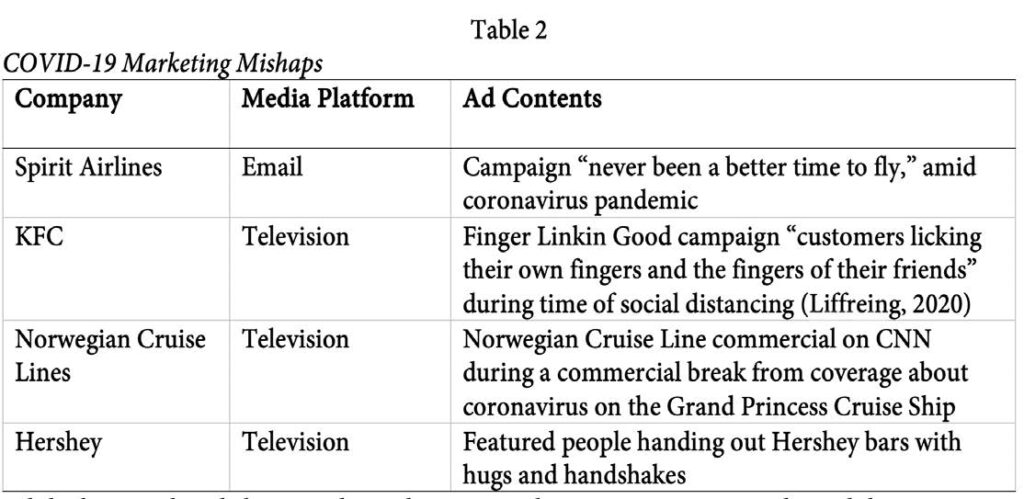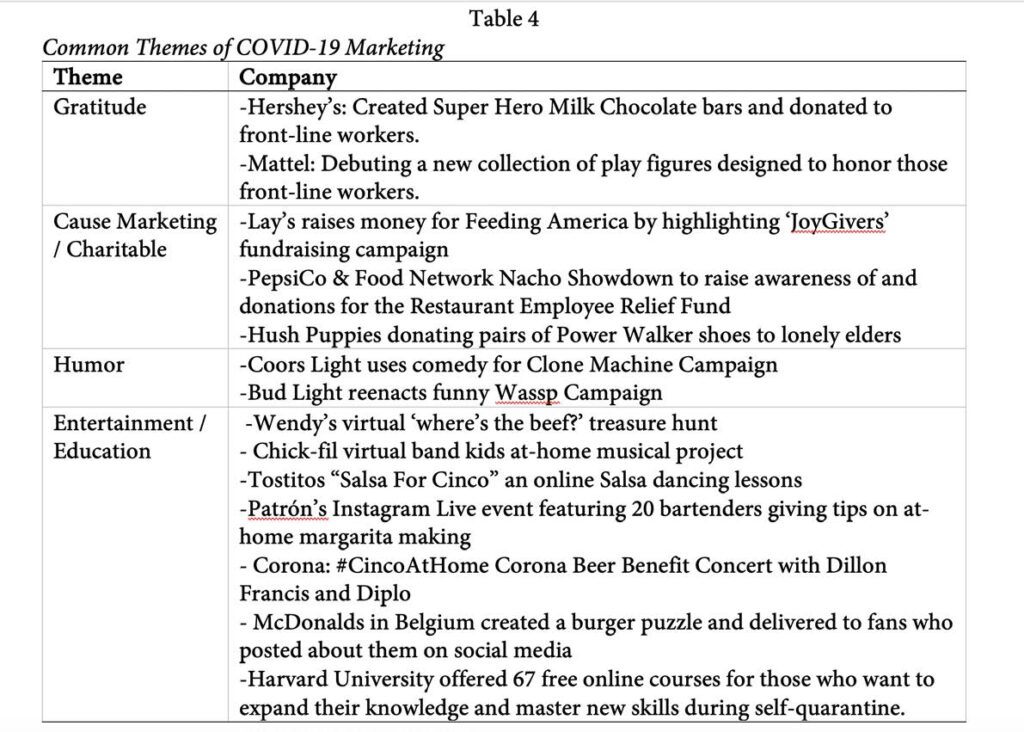Formulating long-term marketing plans is an integral part of branding and corporate communication. The strategic plan guides all marketing initiatives to ensure a shared vision and consistent branding. However, companies encounter internal and external events that disrupt their previous planned promotions. The COVID-19 pandemic is an example of an incident that required reevaluating pre-established advertising materials and provided an opportunity to formulate new coronavirus-appropriate campaigns. Being flexible, redesigning marketing, and embarking upon crisis management marketing becomes essential. As such, educating students on best practices in marketing during mayhem is crucial.
This paper will outline new learning goals that were integrated into the course BU346: Social Media Marketing to educate students on crisis management marketing communications during the COVID-19 pandemic, the adaption of previously scheduled marketing, and the creation of new campaigns. Table 1 lists the newly formulated learning objectives.

Examine current marketing plans and evaluate need for modifications to automated/prescheduled advertising
Once a marketing plan is established and content has been created, many companies utilize marketing automation to pre-schedule their digital media posts, ensuring materials are posted on a specified date. Hubspot 2020 defined marketing automation as using software to automate repetitive marketing activities such as email marketing, social media posting, and even ad campaigns. Additionally, automation is utilized not just for the sake of efficiency, but also for a more personalized customer experience. Anthony (2015) summarized marketing automation as the use of software to automate marketing processes, such as customer segmentation, customer data integration and campaign management.
The utilization of technology to implement marketing and forge deeper consumer relations is widespread and continues to increase in use. Murphy (2018) suggested that there are 292 platforms to facilitate marketing automation to serve more than 2.5 million websites worldwide. Sweeney (2018) estimated that spending on marketing automation will reach $25 billion by 2023.
While many benefits arise from this technology based preplanned marketing communications, content must be reevaluated based on current events or crisis situations. McDonald (2020) emphasized the important of internal teams and agencies reviewing the content across all communication channels to evaluate or edit the automated or pre-scheduled emails, mobile communications, social posts, and advertisements during the COVID-19 pandemic. McDonald (2020) warned that previously scheduled content can come off as tone deaf or irrelevant during periods of crisis such as the coronavirus. Similarly, Daniel 2018 stated, “When relevant and timely content is not immediately implemented, it can set a business back years in their engagement with prospective and current customers.” p.1.
Students debated the positive and negative aspects of automation marketing and were asked to locate case studies or examples of companies who failed to modify their marketing during the virus and assess potential negative branding implications. Table 2 outlines examples marketing mishaps of companies that did not edit previously scheduled marketing efforts during COVID-19.

While the cases listed above made marketing mistakes, many companies adjusted their advertising initiatives. A survey by the Advertisers Perceptions Company sampled 203 of the Ad Pros affiliate companies to gather data on modifying marketing campaigns during the COVID-19 pandemic. Table 3 illustrated how the coronavirus has impacted adverting efforts of the sample. See Table 3.

Analyze case studies to identify themes and effectiveness of COVID-19 marketing
Next, students were asked to conduct research to locate examples of COVID-19 marketing campaigns to identify common themes that were utilized. Students investigated hundreds of digital advertising campaigns on social media platforms such as Facebook, Instagram, and Twitter and email to identify commonalities throughout. After collecting this data, students classified the advertising campaigns into common groups or themes entailing: gratitude, cause/charitable marketing, humor, and entertainment/education.
Gratitude campaigns conveyed appreciation towards COVID-19 front line workers who potentially exposed themselves to harm in order to protect the larger population. This type of marketing took the form of email blasts and social media posts.
Next, cause/charitable marketing occurs when companies collaborate with a charity to raise funds to donate or enhance awareness. During the virus, this was frequently done in conjunction with gratitude campaigns. Francisca, Keith, Lilian, & Milton (2008) suggested that firms are increasingly engaging in cause marketing (CM), i.e., joining with charities or social causes to market a product or service. Cause marketing is embarked upon not only to serve a company’s mission to serve or passion towards a charitable cause, but it is also a sales or public relations function. Krishna & Rajan (2009) attested that consumers obtain both a direct utility benefit from purchasing a product linked to a cause, and also obtain a spillover utility benefit from purchasing other non-cause-marketed products in the CM firm’s portfolio.
The next theme identified was the use of humor in advertising. Mainer (2017) found that humor is a powerful marketing tool because it stimulates a level of cooperation towards a brand, awakens the parts of the brain which are responsible for memorizing the information, and assists a campaign in going viral. Stanley (2020) attested that during the first few weeks of COVID-19, companies were nervous about appearing insensitive and inappropriate in response to cancelled events and mounting numbers of cases. Stanley continued to suggest that now advertisers are entering a second phase in response to the global coronavirus pandemic and it’s one that will include more jokes.
Entertainment/Education themed COVID-19 campaigns attempted to capitalize on the boredom, newly found free time, or the desire to grow/learn during the pandemic of potential customers and target markets. Such campaigns educated consumers on everything from bartending, to building, to complimentary courses offered by prestigious universities. See Table 4 for examples of companies who utilized these commonly identified themes.

Conclusions
In conclusion, the COVID-19 pandemic was used as a teaching moment for BU346 Social Media Marketing Students. Specifically, students compared the positive and negative aspects of automation marketing and the importance of modifying prescheduled communications. Additionally, students analyzed the corporate communications of well-known companies’ television and social media platforms and identified commons themes employed throughout COVID-19 Marketing. It was concluded that most companies integrated gratitude, cause marketing, humor, and education/entertainment into their COVID-19 branding strategy.
References
Advertisers Perception (2020, March 20). Coronavirus effect on advertising report. https://www.advertiserperceptions.com/wp-content/uploads/2020/03/03.25.2020-Coronavirus-Effect-on-Advertising-WEBINAR-PDF-1.pdf
Anthony, B. (2015). What is marketing automation? Journal of Direct, Data and Digital Marketing Practice, 17(2), 84–85. https://doi.org/10.1057/dddmp.2015.46
Daniel, M. (2018). Silver bullet or millstone? a review of success factors for implementation of marketing automation. Cogent Business & Management, 5. https://doi.org/10.1080/23311975.2018.1546416
Francisca, F., Keith, J. P., Lilian, S. O. W., & José Milton de Sousa Filho. (2008). Cause related marketing: consumers. Bar – Brazilian Administration Review, 5(3), 210–224. https://doi.org/10.1590/S1807-76922008000300004
Hubspot (2020). What is marketing automation? https://www.hubspot.com/marketing-automation-information
Krishna, A., & Rajan, U. (2009). Cause marketing: spillover effects of cause-related products in a product portfolio. Management Science, 55(9), 1469–1485. https://doi.org/10.1287/mnsc.1090.1043
Liffreing, I (2020, March 16) . These ads have been pulled or are getting backlash. https://adage.com/article/cmo-strategy/7-brands-ads-unfortunately-timed-coronavirus-pandemic/2244631?CSAuthResp=1%3A%3A5351527%3A0%3A24%3Asuccess%3A1CAF9EA6B819852C1607870B4BDC895F
Mainer, P (2017, August 15). What is the role of humour in marketing? https://www.mycustomer.com/community/blogs/petramainer/what-is-the-role-of-Humour-in-marketing
McDonald (2020, March 17). Customer communication in the COVID era. A 7-step guide for marketers. https://acoustic.com/blog/acoustic-COVID-19-communications-guide/
Murphy, D. (2018). Silver bullet or millstone? A review of success factors for implementation of marketing automation. Cogent Business & Management, 5(1) doi:http://dx.doi.org.library.georgian.edu:2048/10.1080/23311975.2018.15464
Stanley, T.L. (2020, March 22). Humor isn’t out, but it needs to be “heavily scrutinized.” How Marketers and Agencies Are Trying to Strike the Right Tone in the Age of Coronavirus. https://www.adweek.com/creativity/how-marketers-and-agencies-are-trying-to-strike-the-right-tone-in-the-age-of-coronavirus/
Sweeney, E. (2018, May 07). Forrester: Marketing automation spend will reach $25B by 2023. https://www.marketingdive.com/news/forres ter-marketing-auto
